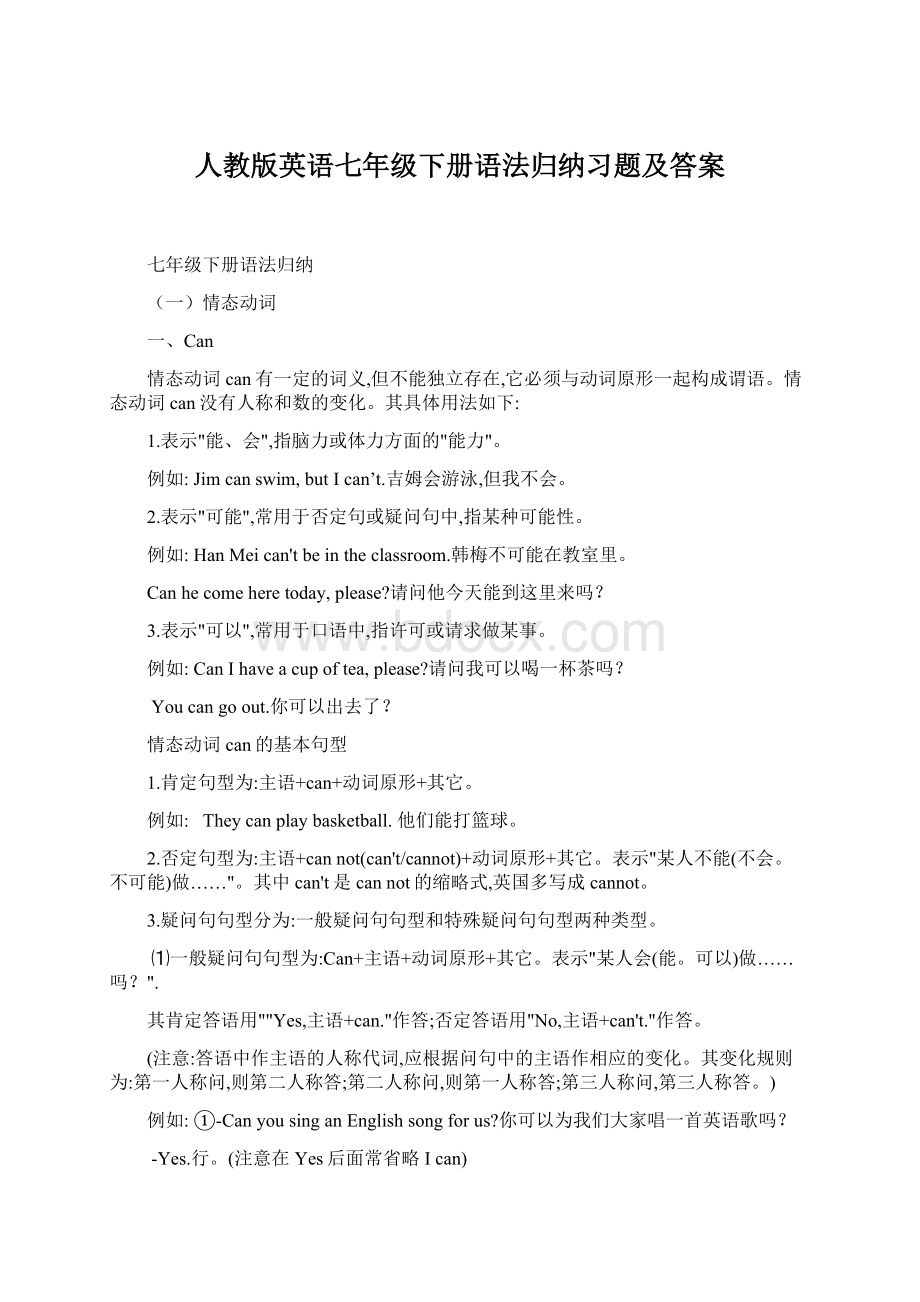人教版英语七年级下册语法归纳习题及答案文档格式.docx
《人教版英语七年级下册语法归纳习题及答案文档格式.docx》由会员分享,可在线阅读,更多相关《人教版英语七年级下册语法归纳习题及答案文档格式.docx(20页珍藏版)》请在冰豆网上搜索。

t是can
not的缩略式,英国多写成cannot。
3.疑问句句型分为:
一般疑问句句型和特殊疑问句句型两种类型。
⑴一般疑问句句型为:
Can+主语+动词原形+其它。
某人会(能。
可以)做……吗?
"
.
其肯定答语用"
Yes,主语+can."
作答;
否定答语用"
No,主语+can'
t."
作答。
(注意:
答语中作主语的人称代词,应根据问句中的主语作相应的变化。
其变化规则为:
第一人称问,则第二人称答;
第二人称问,则第一人称答;
第三人称问,第三人称答。
)
①-Can
you
sing
an
English
song
for
us?
你可以为我们大家唱一首英语歌吗?
-Yes.行。
(注意在Yes后面常省略I
can)
②-Can
skate?
我可以滑冰吗?
-Yes,
can.可以。
③-Can
she
climb
hills?
她能爬山吗?
-No,
t.不,她不能。
拓展:
⑵特殊疑问句句型为:
a.
Who+can+动词原形+其它。
该句型中who相当于主语。
-Who
your
class?
你们班上谁会用英语唱歌?
-Lily
can.莉莉会。
b.特殊疑问词(作定语)+名词+can+主语+动词原形+其它。
该句型中的特殊疑问词常用howmany,
how
much等。
-How
many
boats
see
river?
你能看见河中有多少只船吗?
-Only
one
boat.仅有一只。
c.特殊疑问词+can+主语+动词原形+其它。
该句型中的特殊疑问词常用what,
where,
when等,一般用肯定陈述句作答。
-What
picture?
你能在图画中看到什么?
-I
some
birds
and
two
big
trees
it.我能看到一些鸟儿和两棵大树。
(中考模拟)—Look!
Someoneiscuttingatreeonthemoon.
—Itbetrue,Granny.Mumsaysthereisnoairthere.
A.can’tB.mustn’tC.mayD.should
解析:
根据thereisnoairthere判断出月亮上根本不可能有人在砍树,所以表示不可能。
答案选A。
(中考模拟)Theboycanplay______chesswell,buthecan’tplay______piano.
A.the;
the B.the;
/ C./;
the D./;
/
play后面跟表示球类(运动)的名词时,中间不用冠词the;
而跟表示乐器的名词时,中间应用定冠词the。
答案为C。
按要求改写句子。
1.Icanrunfast.
I________________fast.(否定句)
2.Hecanplaybasketballwell.(一般疑问句)
_______he______basketballwell?
3.Shecanplaytheviolin.(变成一般疑问句)
________she_________theviolin?
4.Theycan’tsing.Theycan’tdance.(合并成一句)
They__________sing______dance.
5.Shecansinganddance.(否定句)
She___________sing____________dance.
keys:
1.cannot;
2.Can;
play;
3.Can;
play;
4.can’t;
or;
5can’t;
or
二、wouldlike的用法
wouldlike用来表达意愿,意为“想要”,相当于want,用法亦同want,但比want委婉。
would是情态动词,没有人称和数的变化,可与人称代词缩写为’d,与其它情态动词一样可帮助完成疑问句和否定句。
用法:
1)后接名词或代词,表示具体“要”某样东西
want/wouldlikesth.想要某物I’dlikesomenoodles
2)want/wouldliketodosth.想要做某事,常用于有礼貌的提出邀请、请求或建议。
I’dliketoplaythepiano我想要弹钢琴。
3)want/wouldlikesb.todosth.想要某人做某事
Iwouldlikehimtohelpme.我想要他帮助我。
4)wouldyoulikesome……你想要一些……吗?
(委婉地询问对方的要求时的用语)
该句型常用于征求对方意见。
特别注意该句型中要用some,而不用any,以表示说话人希望得到肯定回答。
肯定回答:
Yes,please.
否定回答:
No,thanks.
5)Wouldyouliketodosth?
你想要/愿意做某事吗?
(向对方有礼貌地提出建议或邀请)
该句型中like可以换成love。
肯定回答:
Yes,I’dlike/loveto.是的,我愿意。
否定回答:
Sorry,+原因。
或I’dloveto,but……
Wouldyouliketogoshoppingwithus?
你想要/愿意和我们一起去购物吗?
Sorry,Ihavealotofhomeworktodo.对不起,我有很多作业要写。
I’dloveto,butIamtoobusy.我非常愿意,但是我太忙了。
练习:
1.----TimandIwillvisittheexhibition(展览)thisweekend.Wouldyouliketojoinus?
----______
A.Welldone.B.that’sright.C.you’rewelcome.D.I’dloveto.
2.----Wouldyoulikesomemilk?
A.Yes,please.B.Thesametoyou.C.Helpyourself.D.Mypleasure.
3.----Wouldyoulikesomemorerice?
----______.Ieattoomuch.
A.No,thanksB.Yes,thankyouC.I’dlovetoD.Yes,please
4.Shewouldlikehermother______totheparkwithheronSunday.
A.togoB.goC.goingD.goes
5.---ShallwestayathomewatchingTVtonight?
---No.I’dlike_____andseeafilm.
A.togo B.go C.went D.going
(二)时态集锦
一、一般现在时
一般现在时:
表示通常性、规律性、习惯性的状态或者动作。
标志词:
always,usually,often,sometimes,never,everyday/night/…inthemorning…onweekends…
主语是第三人称单数
主语不是第三人称单数
肯定句
主语+动词s+其他
主语+动词原形+其他
否定句
主语+doesn'
t+动词原形+其他
主语+don'
一般疑问句
Does+主语+动词原形+其他
Do+主语+动词原形+其他
动词第三人称单数的构成:
(用于第三人称单数、可数名词的单数和不可数名词的一般现在时中)
1、直接加—s:
look—looks read—reads play—plays stop—stops
2.在字母s,x,ch,sh,o后加—es:
miss—missesfix—fixes watch—watches wash—washesgo—goes do--does
3.辅音字母加y结尾的动词变y为i,再加-es:
carry–carriesstudy–studies hurry–hurries cry–cries
4.特殊的 have–has
练习
1.(浙江省)
like
soft
gentle
music.
It
______nice.
A
is
sounded
B
C
sounds
D
sounding
2---Canyourfatherdrive?
-----Yes,he______toworkeveryday
A.isdrivingB.droveC.drivesD.haswritten
3.Johnlikesplayingsoccerverymuchandhe_____aboutonehourplayingiteveryday.
A.spent
B.willspend
C.hasspent
D.Spends
4.AlthoughBillisn'
trichenough,heoften______moneytothepoor.
A.willgive
B.wasgiving
C.gives
D.Gave
5.Weoften___________(play)intheplayground.
6.
__________you_________(brush)yourteetheverymorning.
7.What
________(do)heusually
_______(do)afterschool?
8.
Mikesometimes__________(go)totheparkwithhissister.
5play;
6.Dobrush;
7.does;
do;
8.goes
二、现在进行时
1.表示说话时正在发生或者进行的动作
Pleasedon’tmakesomuchnoise,I’mstudying.
Let’sgetout.Itisn’traininganymore.
2.表示在现在相对较长一段时间内正在进行的动作,但是说话一刻不一定在做的动作
HaveyouheardaboutTom?
Heisbuildinghisownhouse.
DavidisteachingEnglishandlearningChineseinBeijing.
这些动作,在说话时并不一定在发生或进行,而是在包括说话的一刹那在内的一段时间内发生、进行的.
现在进行时的时间状语主要有:
now,thesedays(目前),thisweek,atthemoment(此刻)等,有时句首有“Look!
”、“Listen!
”或“It’s+时刻”等词、句存在。
肯定句:
主语+be+现在分词(主语在前be在后,现在分词跟着走。
否定句:
主语+be+not+现在分词
一般疑问句:
be+主语+现在分词?
特殊疑问句:
特殊疑问词+be+主语+现在分词+其他?
动词现在分词的变化见下表:
词尾情况
变化方式
例词
一般情况
加—ing
play玩—playingdo做—doinggo去—going
see看见—seeingjump跳—jumping
sing唱—singingski滑雪—skiing
以不发音的e结尾
去e加—ing
make做—makingtake拿到—taking
dance跳舞—dancinglike喜欢—likingcome来—coming
write写—writinghave有—havingclose关—closing
以重读闭音节结尾的动词,中间只有一个元音字母,词尾只有一个辅音字母
双写最后一个辅音字母再加—ing
swim游泳—swimmingsit坐—sitting
begin开始—beginningrun跑—running
get得到—gettingput放—putting
jog慢跑—jogging
1.Listen!
They
________
next
room.
A.
B.
singing
C.
are
D.
were
2.It’s
eight
o’clock.
The
students
______
class.
having
3.
---Mary,
could
help
me?
---Wait
moment.
_____.
read
book
B.
did
my
homework
was
watching
TV
D.
am
cooking
dinner.
4.Lookatthe_____!
It'
s_______heavilynow.
A.rain;
rain B.raining;
raining
C.rain;
raining D.raining;
rainy
5.We_______aChineseclasstoday.They________anEnglishclassnow.
A.aren'
thaving;
arehaving B.don'
thave;
have
C.aren'
have D.don'
arehaving
三、一般过去时
1.
一般过去时表示过去
(1)
表示过去发生的动作或存在的状态:
Heboughtthecomputerfiveyearsago.
这电脑是他五年前买的。
Itwasthenasmallfishingvillage.那时它只是一个小渔村。
(2)
表示过去经常性或习惯性的动作:
Weoftenplayedtogetherwhenwewerechildren.我们小时候常在一起玩。
注:
表过去习惯性的动词,也可用usedto或would:
Heusedtogotoworkbybus.
他过去常乘公共汽车去上班。
2.时间状语
与一般过去时连用的时间状语有:
yesterday(昨天),
last
night(昨晚),
week(上个星期),
four
days
ago(四天前),
2002(在2002年),
just
now(刚才),
day
before
yesterday(前天)等。
如:
He
went
to
park
yesterday.
她昨天去了花园。
ten
years
old
2001.
我2001年才10岁。
3.一般过去时态的形式
1.Be动词在一般过去时中的变化:
⑴am
和is在一般过去时中变为was。
(was
not=wasn'
t)
⑵are在一般过去时中变为were。
(were
not=weren'
⑶带有was或were的句子,其否定、疑问的变化和is,
am,
are一样,即否定句在was或were后加not,一般疑问句把was或were调到句首。
2.句中没有be动词的一般过去时的句子
didn'
+动词原形,
Jim
home
一般疑问句:
在句首加did,句子中的动词过去式变回原形。
Did
yesterday?
疑问词+一般疑问句?
What
do
4.动词的过去式
一般过去时的谓语动词要用动词的过去式。
动词过去式的构成分规则变化和不规则变化两种形式,不规则变化通常需要逐个记忆,规则变化则遵循以下原则:
一般在动词后加-ed。
play—played,offer—offered,weigh—weighed,destroy—
destroyed,sign—signed.
在以字母e结尾的动词后,只加-d。
like—liked,provide—provided,hate
—
hated,date—dated。
(3)
在以“辅音字母+y”结尾的动词后,则改y为i,再加—ed。
supply—supplied,fly—flied,study—
studied.(from)
(4)
在以重读闭音节结尾且,末尾只有一个辅音字母的动词后,双写最后一个辅音字母,再加-ed。
plan—planned,refer—referred,regret—regretted,ban—banned.
我们还学过许多不规则动词的过去式形式。
–
was,
were,
put
put,
saw,
eat
ate等
1.请写出下列动词的过去式。
want
arrive
enjoy
shop
_
see
are
eat
2.单项选择。
1)
—Nancy
isnotcomingtonight.
—Butshe
______!
promises
promised
willpromise
hadpromised
2)Timalways_____apictureathome.He_____acarnow.
A.draws;
isdrawingB.draw;
draw
C.draws;
drawD.draw;
isdrawing
3)IthoughtJimwouldsaysomethingabouthisschoolreport,buthe
it.
doesn’tmention
hadn’tmentioned
didn’tmention
hasn’tmentioned
4)I
younottomovemydictionary—-nowIcan’tfindit.
asked
ask
wasasking
hadasked
5)
kid
breakfast
every
morning,
because
it’s
good
his
health.
has
C.
has
6)——Where’s
cake
made
this
morning?
——We
_______
it,
mum.
make
another
ate
will
it
eating
7)
Look!
Two
cats
across
wall.
run
runs
running
D.ran
8)
Jenny
____
office.
Her
parents
____in
hospital
.work;
works
B
.works;
work
work;
working
working;
9)UncleWangknows_______awashingmachine.
A.howtomakeB.tomake
C.howmakingD.whattomake
10)I
want____homework
now.
A.doing
B.to
C.to
D.do
my
3.改